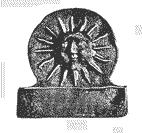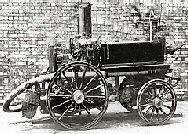

|
Probably the very first organised fire fighters were the "vigiles", who were founded by the Emperor Augustus in around 27 BC to serve as fire fighters and night watchmen in the city of Rome. They were originally drawn from the ranks of freedmen and were not really soldiers, although they were organized on a quasi-military basis. They were commanded by a Prefect of equestrian rank (the praefectus vigilum), and were divided into seven cohorts led by tribunes, with each cohort being responsible for two of the 14 regions of the city. After the Great Fire of London in 1666, the first Fire Insurance companies began to make an appearance along with their own fire brigades to improve profit margins. Fire marks, made of lead and later of copper, appeared on the front of a house as soon as the insurance was completed and the premium paid. These marks served to identify if the property was covered, so that the company's fire brigade on arrival could see if their services were required. The practice of fixing fire marks to insured properties persisted right up to the 1860's, long after their original purpose was forgotten. In 1832, the London Fire Engine Establishment was created by merging all the engines of the contributing fire office's, and was managed by a committee consisting of a representative of each contributing fire office. Around the same time, other municipal brigades began to appear, including Edinburgh in 1824, and Manchester in 1828. In 1865, The Metropolitan Fire Brigade Act placed the responsibility for extinguishing fires on a public authority. This led to the London Fire Engine Establishment's replacement in 1866 by the Metropolitan Board of Works, which later became London County Council.
Throughout the remainder of the 19th century and into the 20th century, many fire brigades, both professional and voluntary, appeared throughout the country. There was, however, no statutory requirement on any local authority outside of London to make provision for a fire fighting force. It was not until the introduction of the Fire Brigades Act 1938, that legislation created 'fire authorities' throughout the United Kingdom, requiring them to provide a fire-fighting organisation for the area under their control. The 1938 Act in effect removed the power for parishes to operate fire brigades and, for the first time, laid down clear requirements to county boroughs and county districts, as newly designated 'fire authorities', for the provision of organised fire protection in England and Wale, with similar requirements being placed on county councils and burghs in Scotland. These new requirements were in addition to those imposed on the London County Council. Following the introduction of the Fire Brigades Act 1938 there were some 1500 fire brigades around the country organised in a variety of forms. This re-organisation of fire protection had only just begun to function when the outbreak of the Second World War placed a burden on fire brigades requiring a level of response never before experienced in the history of fire fighting. A further change occurred on 18 August 1941 when all existing local authority fire brigades, together with members of the Auxiliary Fire Service, combined to form the National Fire Service (NFS), which continued in existence until 1 April 1948. The task of looking at the structure of a post- war fire service began in March 1944, when a committee consisting of eminent fire service personalities produced a report to the Secretary of State with their recommendations. This resulted in the Fire Services Act 1947, which received Royal Assent on 31 July 1947. This Act of Parliament became effective on the 1st of April 1948, and resulted in 148 County Council and County Borough run Fire Brigades. The Auxiliary Fire Service came into being in 1938, and was mobilised on the 1st of September 1939 and then disbanded at the end of the Second World War. In 1948, the Civil Defence Act re-established the Auxiliary Fire Service and the Civil Defence Corps because of the Government's concern over the deteriorating relations with the Soviet Union and Eastern Europe. The AFS finally disbanded in 1968 along with the rest of the Civil Defence.
Witheridge did not receive their own local fire engine until 1946, when, as a result of great pressure following the Tracey Green fire in 1945, the Witheridge Fire Brigade was formed as part of the then National Fire Service. The first engine was a converted post office telephone van and tender, and was stationed in the former bus company garage in North Street. Previous Last Edited 03/07/2006 Copyright © 2000-2006 Witheridge Unless otherwise indicated on the page in question, the photographic images reproduced on this site belong to the Witheridge Archives, and, as such may not be reproduced for commercial purposes without written permission. However, you are welcome to use any of the photographs belonging to the archive for personal and/or non-commercial use. Any material shown as not being owned by the archive may not be reproduced in any form without first receiving written permission from the owner of the material in question. |




